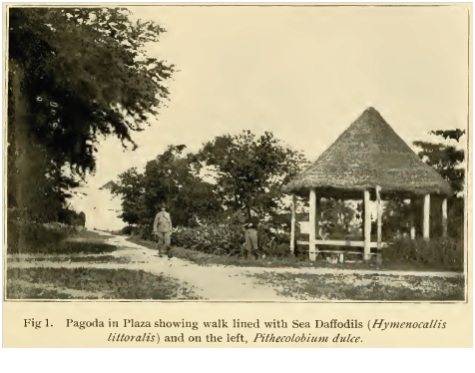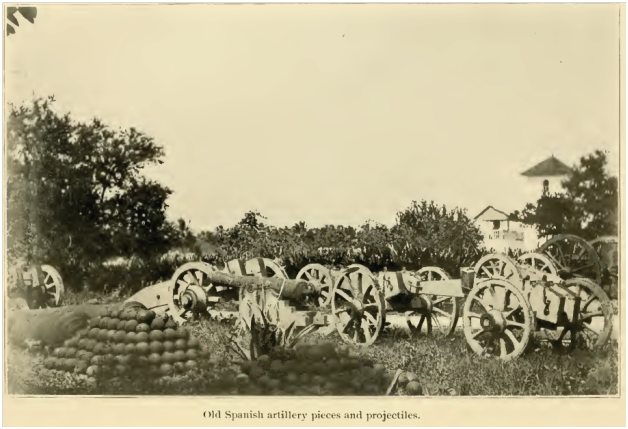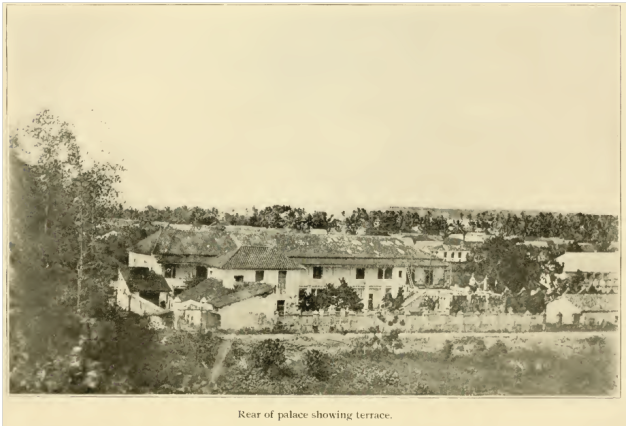Monday, August 14, 1899...
"...Made arrangements with Henry Mellinchamp [sic], the pilot, to take my meals with him at forty pesos ($20.00) a mouth. Met his wife, Doña Emilia [Castro] Anderson, who is said to be the most attractive and witty matron of Agaña. She is the grand-daughter of John Anderson, a Scotchman, who settled in Guam about 1819, and served the government as pilot and interpreter for years. The eldest daughter [Maria Victoria Anderson Millenchamp] of Henry and Dona Emilia is the wife of Captain Pedro [Maria Andujar] Duarte, of the Spanish Army, who served as military aid to the late Spanish governor of Guam. Don Pedro is about to resign his commission in order to remain on the island with his wife and little ones.
Back to the ship for the night."
(Note: Lt. Safford arrived on Guam on the Yosemite and during his tour on Guam served as the first Deputy Governor of Guam; following the cessation of Guam from Spain to the U.S. negotiated in the Treaty of Paris. He known for his journals published in 'The Plant World.')
Tuesday, August 15, 1899
Have received orders to relieve the acting governor, Mr. William Coe, and to take up my residence at Agana, the capital of the island, I have also been appointed Judge of the First Instance, Registrar of Deeds and Titles, and am to act as Auditor of the Treasury. For the present, while the Palace is undergoing repairs, the Governor will remain on board the Yosemite and I will have charge of the government in Agana.
Mr. Coe is a half-caste Samoan, son of Captain Billy Coe, the well known pilot of Apia, to whose stories of adventure I have many times listened when visiting him in the trim little cottage on Matauta Point, where he used to sit day after day with his glass at hand scanning the horizon for approaching vessels. Coe, the son, came here shortly after the American occupation, accompanied by his young wife, a sweet-faced, gentle, brown-skinned woman, daughter of a Caroline Island chief. He was appointed acting governor by the officer in charge of the "Nanshan," to relieve Don Joaquin Perez y Cruz, formerly Gobernadorcillo of Agana, who had been entrusted with the government of the island together with a junta composed of Rev. Jose Palomo y Torres, the parish priest, Don Juan Torres y Diaz, Don Vicente Herrero y Roberto, Don Luis Torres y Diaz, and Don Antonio Martinez y Pangelinan, principal citizens of Guam, natives of the island and all men of intelligence and breeding. A misunderstanding had arisen on account of the delivery of a part of the material of war remaining on the island to the representative of Spain sent hither to take possession of it, in accordance with the provisions of the treaty of peace. Don Joaquin resigned his charge, and William Coe was appointed in his stead.
Took up my residence over the Treasury, on the right of the Palace, in the quarters formerly occupied by Sisto [last Spanish Governor]. My Japanese boy, Miyomoto, helped me to unpack my clothing and books. Among the latter I have 200 volumes from the library of the late Robert Louis Stevenson, sold to me by Mr. Blacklock, of Apia, with the authority of Mr. E. W. Gurr, Solicitor of Mrs. Stevenson. My furniture consists of a canebottomed bed with high posts supporting a mosquito-net canopy and curtains, a table of a polished native wood called Ifil, several chairs, and a Chinese earthen-ware bath-tub, like a jar, with representations of bamboos, etc., in relief on the outer surface, kindly lent me by Mr. Henry Mellinchamp, the pilot (he refused to accept money for it).
Miyomoto has had a great time sweeping, dusting and cleaning the rafters from cobwebs. My rooms are large and well ventilated. They are unceiled, and the roof-tiles above give them a somewhat unfinished look. On two sides I have a balcony enclosed with shutters and sliding windows which, instead of glass, have thin translucent bivalve shells, somewhat like those of a pecten. From my balcony I can look in one direction across the plaza toward the old church, with the Palace on my right and the Tribunal, or jail, on my left; in another direction I look down on my garden, a tangled mass of tropical growth. On the walls I find records of children's games: "Dolores, 1111; Mercedes, 111; Carmen, 11111; Concepcion, 11; Vicente, 11111; Juan, 111." Behind the shutters and the doors are swarms of Tipulae, like great slender-legged mosquitos, which set up so vigorous a vibration as to look like vague clouds. Under the eaves I find securely glued a number of tiny lizards' eggs. The lizards, or more strictly speaking, geckos, run about the roof, upside-down, without apparent effort, holding to the rafters and tiles by their padded toes, catching flies and moths, and every once in a while chattering like a bird...
Called on Father Palomo, the parish priest, and found him to be a man of refinement and breeding. He speaks English and French very well and is familiar with the classics of our language as well as with the principal Spanish, French, and Latin writers. I was surprised to find a native so highly accomplished. As a young man he studied with the parish priest, perfected his English and French by conversation with visitors to the island, and went to Manila, where after a course of study he was ordained to the priesthood. His mother was a descendant of Don Luis Torres, the Sargento Mayor of whom Kotzebue, Freycinet, Gaudichaud, and Dumont d'Urville speak with great respect in the narratives of their travels. Employed Jose de Torres as my secretary. He will help me in my botanical collecting and in copying from then archives of the government, in which there is much of historic and economic interest.
Dined at the house of Henry Mellinchamp, the pilot, where I had a most interesting conversation with his son-in-law, Don Pedro Duarte, Captain in the Spanish Army, late Military Secretary to the Governor of Guam. Don Pedro was taken with the other officers to Manila on the "Charleston," but was allowed to return to his family in this island. He speaks in the highest terms of the courtesy with which he was treated by our officers both during the passage to Manila and while a prisoner there. During his absence his wife was very ill. She grieved for him and did not know whether she would ever see him again. A baby was born, but it died. Dona Maria still looks delicate, but the bright-eyed children are pictures of health. Don Pedro is an engineer of ability. While serving on detached duty in the Philippines he often had to act as surgeon to his men and to dispense medicines; so that he acquired from his books and experience considerable knowledge of the diseases of the tropics and their treatment. He says he intends to remain in the island and will follow its destiny.
(Note: Lt. Safford arrived on Guam on the Yosemite and during his tour on Guam served as the first Deputy Governor of Guam; following the cessation of Guam from Spain to the U.S. negotiated in the Treaty of Paris. He known for his journals published in 'The Plant World.')
Reference:
Safford, W.E. (1902). Extracts from the Note-Book of a Naturalist on the Island of Guam. The Plant World, Volume 5. Washington, DC: The Plant World Company








